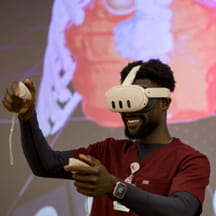Jane Burns, MD, has spent her entire career trying to unlock the mystery of Kawasaki disease. It’s a rare condition that causes symptoms such as a high fever, rash, and peeling skin in young children. If not properly treated, it can lead to life-threatening blood vessel inflammation. Sometimes, the damage doesn’t manifest until years after the original illness.
Burns’ quest to understand—and cure—Kawasaki disease began during her pediatric training in the early 1980s and has led her to investigate possible causes and triggers, including climatology and genetics. Along the way, she’s assembled a multi-disciplinary team of researchers, data analysts, epidemiologists, and non-medical scientists of which she labels herself “the cheerleader-in-chief.”
“After 40 years of sort of spinning our wheels, I think we're finally off and running in a good direction,” said Burns, the inaugural appointee of the Gordon and Marilyn Macklin Foundation Endowed Chair in Kawasaki Disease Care and Research and director of the Kawasaki Disease Clinic at Rady Children’s Hospital-San Diego.
Children’s Hospitals Today recently caught up with Burns to discuss the current state of her research and tools like big data and artificial intelligence she’s using to solve this puzzle.
How has your research led you to investigate the role of the climate in Kawasaki disease?
We collaborate very closely with our colleagues in Japan, where Kawasaki disease is much more common. The attack rate in Japan is about 350 per 100,000 children under 5 years old; it's not a rare disease there. They have an enormous database of more than 420,000 patients with the date of onset of their fever and the location of every patient down to the municipality level.
Our climate team has been able to dig into that data, and the important observation is that the incidence is rising sharply. Among school-age children, Japan has had 1,000 more Kawasaki disease patients every year despite a falling birth rate.
There's no infectious disease in the world—COVID-19, influenza, or anything else—that has this kind of increase in the number of affected people every year. The only way this can be happening is that there's a trigger, or at least a contributing factor, which is exposing large numbers of children in Japan with increasing intensity over time. There's also a geospatial coherence, meaning that the numbers of Kawasaki disease patients in all of Japan goes up or down in a very coordinated way over a wide geographic swath. With influenza or COVID you don’t see this mass scale increase and decrease—this is a new paradigm in disease.
How important is the role of genetics in the incidence and severity of Kawasaki disease?
It’s very important. In a sense, everything that happens to you in your life is in some way related to your genetics, right? But with Kawasaki disease, the association is obvious. We’re at a moment now in molecular biology and in the way we think about disease, where there's such a potent element of genetic predisposition for this disease—not only genetic susceptibility to who gets the disease, but also to their outcomes. What we’re seeing is that 75% of children with Kawasaki disease have the genetic predisposition to develop the symptoms but not the terrible heart damage—even without treatment. The other 25% have an additional genetic piece that puts them at risk for heart complications.
Why do you feel that your research is turning a corner now after four decades of work on this disease?
For one, the idea that we look at this disease from so many different lenses and we're taking approaches that involve genetics, big data, and artificial intelligence. Also, we’re incorporating climate, wind, and an epidemiologic analysis that is quite different than what doctors usually do—we’re trying to take a mysterious disease and attack it in a multi-modal kind of way.
And the availability of big data is a huge development. A perfect example is Children Hospital Association’s PHIS database (Pediatric Health Information System ®), which has been an incredibly valuable research tool. For rare disease research, it is the only place that we can really get a handle on what's happening across the United States. For that, it’s our go-to source.
How are you leveraging your research findings to improve outcomes for these patients?
We know that the age group at highest risk of heart damage is infants. Eighty-five percent of our patients are below the age of 5 because, for most of these children, the environmental trigger for the disease is prevalent enough that they don't get very far in their life before encountering it. We've started intensifying therapy for patients younger than 6 months old and have had fabulous outcomes—we've prevented heart disease in the vast majority of our very vulnerable young infants.
Ultimately, we need to get to a place where there’s a test that can identify Kawasaki disease in these children, because we know we really can prevent or mitigate the risk of heart damage by jumping on it early, treating it aggressively, and intensifying initial therapy beyond just IVIG (intravenous immunoglobulin treatment). We can prevent this lifelong damage if we get to the patients in time, if they're diagnosed. But we can't go out into the community and find them, so we really need that type of tool.


